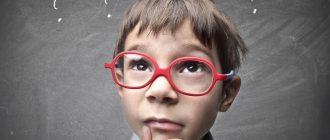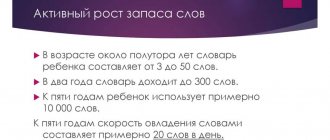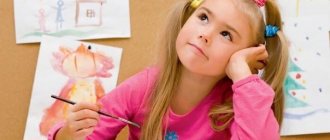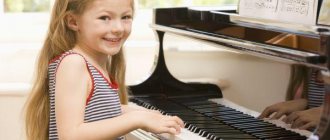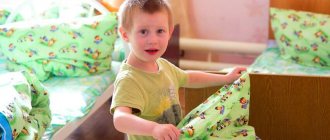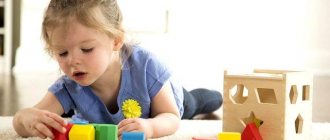Formation of memory as a basic mental function
The cognitive development of a child is unthinkable without the active use of memory. This mental process allows you to accumulate, store and recall the necessary information. The memory of a preschooler expands its capabilities every year.
In the first years of life, memory is formed as a component function of perception. The most striking characteristics of those objects that are perceived by a child are involuntarily recorded by brain cells. Information is accumulated about surrounding people, about various objects, about their properties, about repeated actions. At the age of three years, memory already acts as an independent cognitive function.
The simplest form of recollection is manifested in the baby's recognition of objects that he has already seen, heard or touched before. In preschool age, the functional capabilities of receiving and retrieving information are actively developing, which ensures more complex memory work. A preschooler uses all memory functions:
- memorization
- preservation
- recollection
- recognition
- playback
Memorization is carried out by “linking” new material to already familiar material. For a preschooler, such consolidation occurs fleetingly. Children do not yet know how to use special memorization techniques.
Retention is a mental process that ensures that information is retained for a certain time. It can be both short-term and long-term. Young children can remember for a long time what caused special emotions. Fear may linger for a long time, but the baby can also retain impressions of joyful events.
Recall is the process of retrieving previously remembered information. The request on the way home: “Mom, buy me a doll like Olya’s” is nothing more than a recollection of one’s own admiration for Olya’s treasure.
Recognition is an easier way to remember familiar information because it relies on a newly seen, heard, or felt stimulus.
Reproduction is a complex process of retrieving already stored material. The limited life experience of a preschooler also imposes restrictions on the reproduction of information. The child remembers under the influence of similar impressions.
The main feature of a preschooler's memory is the predominance of involuntary memorization. Playback works the same way.
Proper and nutritious nutrition improves memory performance
Pay attention to what your child eats, balance proper and nutritious nutrition for a growing body.
You can improve brain nutrition with the following foods: greens, fruits, vegetables, dairy products, nuts, berries, cereals.
Proper nutrition is the key to your child’s good health and improved memory. Food greatly influences the development and improvement of memory. They contain a large amount of useful substances for a growing organism.
What types of memory predominate in preschool age?
Activation of a preschooler's memory occurs through perception. Information reaches the child through visual, auditory, taste, and tactile receptors. The received signals form a certain image that the child remembers. For this reason, due to nature, the predominant type of memory in preschoolers is figurative.
The following types of memory develop intensively in preschool children:
- figurative
- verbal
- motor
Figurative memory helps the child master new concepts and expand his vocabulary.
Having heard that a zebra is a “striped horse,” the child vividly forms the image of the animal. The new information for him is the word “zebra” itself.
Perhaps the child’s imagination drew a not quite similar image. In reality, it will correct itself. In the meantime, the new word will already be firmly established in the preschooler’s vocabulary. The formation of verbal-logical memory occurs.
Thus, the development of memory in ontogenesis goes from the predominance of figurative to the use of verbal forms. We can say that speech takes a preschooler’s memory to a higher level and increases its productivity.
Motor memory in preschool age is oriented towards a given pattern. These are no longer the simplest movements (assembling a pyramid, threading a button through a loop) that are mastered at an early age. A preschooler, looking at an adult, learns dance movements. Masters such complex household operations as tying shoelaces and sewing on buttons.
Memory of children of primary preschool age
In early preschool age, images are formed on the basis of practical actions. A 3-4 year old child learns about the world through actions and remembers the most important things for himself.
Information is stored fragmentary, in the form of figurative single representations. So, a child may be afraid of Santa Claus, and no explanation that dad dressed up in this costume for the next holiday will help.
At this age, the most emotional events, bright objects, and frequently repeated actions are remembered.
The separation of features and their generalization during comprehension and memorization is formed due to the development of speech. When a preschooler masters more concepts and uses words, his perception becomes more stable. This, in turn, helps the child associate the content with a specific word and remember it as an image. But in younger preschoolers, such linking occurs involuntarily.
Features of memory in older preschool age
The older a preschooler gets, the stronger the connection between memory and thinking becomes. The child masters his native language, learns to analyze, compare and generalize. As a result, images are remembered through mental operations.
The older preschooler himself makes up descriptive definitions in order to remember the new concept. “An escalator is also a staircase, only it moves,” “The blackberry is called that because it is covered in thorns, like a hedgehog.”
But in older preschool age, in order to remember and remember, support in the form of an image is not always needed. Poems are remembered for their rhythm and rhymes, as the sound culture of speech develops. When retelling a fairy tale or story he has heard, the preschooler relies on a logical sequence of events. Although he can equally imagine himself in the role of one of the characters, which promotes memorization.
The peculiarities of memorization and reproduction in older preschool age also manifest themselves in the fact that they gradually acquire an arbitrary character.
Favorite hobbies and physical activity help develop memory
Each child has his own hobbies, and even a calling, watch your child, pay attention to what your child is drawn to, what he wants to do, maybe it’s music, dancing, sports or drawing.
All children are different and their hobbies are also different. There is no need to compare yourself with your child; your hobbies may not coincide at all.
Very often, parents themselves decide who their child should be, they do not give the right to choose to their child, and make all decisions themselves.
The main mistake of most parents is to impose their decisions.
If your child likes to draw, there is no need to send him to a music school, because you yourself have dreamed of becoming a great pianist all your life and you were not allowed to do so.
Do not discourage your child from doing what he loves, you can ruin his whole life.
A child's hobby, it can be the basis of a child's entire life; by doing what he loves, the child will have a desire to learn and study more because he likes it.
There will be no need to force him, he himself will be happy to read additional literature, and his memory will develop on its own.
If your child’s hobbies are not related to sports, then on weekends try to walk more with your child in the fresh air; the child’s brain and your brain need oxygen. Play active games with the whole family, skiing, skating, roller skating, playing ball.
Formation of arbitrary memory
The prerequisites for the development of voluntary memory in a preschooler are personal age-related changes. Volitional functions begin to form. The child learns to subordinate his actions to accepted rules; at the suggestion of an adult, he tries to control his speech and pronounce words correctly.
In preschool age, the formation of will-controlled mechanisms that control behavior and activity occurs.
The use of volitional efforts is manifested in relation to every cognitive process, including memory.
It is interesting that remembering first becomes arbitrary. A mother will ask a 3-year-old child where he put his toy, and the child will try to remember. And, often successfully.
Voluntary memorization comes later. The exception is a simple chain of actions. Younger preschoolers remember well how to play a “melody” of three notes on the piano, and how to put together an elementary structure according to a pattern.
Patterns of formation of arbitrary memory
The development of voluntary memorization is subject to certain patterns. It is not immediately that a preschooler comes to the point of aiming to learn certain information. First, an adult formulates such a goal for him: “Let’s learn a poem,” “I’ll show you a few pictures, try to remember what is shown in them.”
Even with an immediate response, the child will show attention too superficially. The first result will be weak.
If a preschooler is somehow affected by a disappointing indicator, he will agree to try again. Reproduction will be more successful, but not sufficient.
Only when the child himself realizes that he is experiencing difficulties in reproduction will he direct efforts to remember every word, every picture.
From here follow the conditions for the development of voluntary memory. For effective memorization, a preschooler must have a motive. Motivation can be different: competitive (to remember more than others), a challenge to oneself (I will remember the first time), responsible (I must remember in order to convey it accurately).
Good relationships, care and attention improve a child's memory
If your family has good, friendly relationships, then your child will always remember new information with ease. Try to create a friendly environment in your family, peace, good relationships between parents and children, always have a positive effect on the development of the child’s memory and attention.
When a child sees good relationships in the family, with parents and other family members, then it is easier for him to study, he studies with joy. A child wants to study in a good environment at home and wants to please his parents and other relatives with his successes.
Create a good atmosphere in the family, love your child, spend a lot of time with him, surround him with care and affection, so that the child feels that he is not alone, that he is loved and will always help him.
When there are good relationships in the family, then everything turns out well for the child, his memory becomes better, and his head is not filled with quarrels between his parents.
Games and exercises for developing memory in preschoolers
Game: “Explain without words.” Goal: development of motor memory. A game for a group of children from 4 years old.
One child stands next to the adult, the rest turn their backs to them. The adult shows the child a series of movements that contain certain information. For example, he walks (I went into the bathroom), imitates washing his hands and washing his face (I washed my hands and washed my face). The child immediately repeats after the adult. And when the other children turn to face them, he reproduces the entire series of sequential movements for them. Participants must guess what the child was trying to tell them. The complexity of the selected movements and their number depend on the age of the children.
Game "What's missing?" Goal: development of figurative memory.
To play, you will need 3 to 7 small objects (depending on the age of the children), for example, small animal figurines.
It is better to play the game individually or in a group of no more than three children. The figures are lined up, each is named and discussed. Next, the child is asked to close his eyes, and the adult quietly removes one figure. In the case of animals, a game task for a child might look like this: “Look, who’s missing? Who went for a walk?" And the task arises of remembering all the figures that were presented and determining which one is missing.
Exercise “What did it sound like?” Goal: development of auditory memory.
The exercise uses musical toys, for example, a bell, a rattle, a tambourine, a drum.
Toys are shown to the child. He can explore them, listen to how they sound. The adult suggests the name of each item. After this, the child turns away, the adult rings the bell, for example. Game task for a child: name which toy makes such a sound.
Exercise “Remember and name.” Goal: development of short-term memory.
To carry out the exercise, you need to find a plot picture, for example, which depicts children playing.
The child studies the picture together with the adult, names what objects are depicted, and describes them. After this, the picture is hidden, and the child is given the task: “Remember what you saw in the picture?” If difficulties arise, you can prompt the child by asking questions.
Game "What's in the bag?" Goal: development of indirect memorization.
To play you need a bag and 3 to 8 small objects, for example, a ball, a bell, a pencil, an apple.
Looking at each object, the child comes up with what it looks like, for example, a ball - like the sun, a pencil - like a stick. After this, all the items are collected in a bag, and the adult gives the task: “Remember what I have in my bag according to my clue words.” And so the child, according to the definition word, must remember all the objects: the sun - a ball, a stick - a pencil, and so on all the others.
The role of play in the development of memory in preschool children
Play is the leading activity for children aged 4-6 years, so the development of memory in children of this age group involves the use of gaming techniques that increase the motivation to remember. For example, by playing the role of a buyer in a game, a child can remember the list of products that he should purchase. But memorizing the same list outside the game will not be so productive and will require a significant number of repetitions.
The development of memorization is facilitated by finger games, which involve establishing a connection between a word and an action and ensure the child’s activity in mastering new knowledge - the baby, listening to the adult, repeats the movements after him. After several repetitions, the child will try to independently reproduce not only the movements, but the words.
